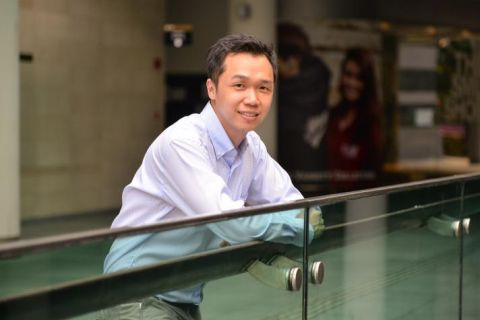
While it is logical to expect happy people to be more creative, SMU Assistant Professor Ronald Bledow’s research suggests that negative emotions may lead to particularly high levels of creativity.

Photo Credit: Cyril Ng
By Rebecca Tan
SMU Office of Research (17 Apr 2014) – Artists, business people and scientists all require creativity to do well in their respective professions. Not only is creativity required for problem solving on a daily basis, it ultimately creates value in the form of original ideas or products.
Many researchers have sought to understand the factors that best foster creativity, and there is growing recognition that emotions, also known as ‘affect’ by psychologists, play a significant role. The psychological underpinnings of creativity, and their subsequent impact on value creation in the workplace are what Assistant Professor Ronald Bledow of the Singapore Management University (SMU) Lee Kong Chian School of Business examines in his research.
Creativity cannot be rushed
What Professor Bledow has found in the course of his research is that creativity cannot be rushed. In one study, he looked at student teams working on real world projects where the task was to come up with an innovative engineering solution. He was interested in the inception of originality, and how students who produced unique work behaved over the course of time.
“We found that the critical decisive factor was how long students spent on creativity. The students who were less original basically jumped the gun. They started very quickly, hatching the first idea they had come up with. They looked very successful to themselves in the beginning, because they very quickly got things done and started to move forward. However, the much more original teams were those that didn’t do a lot of realisation activity in the first few weeks of the project.
“At some point, one has to focus on realisation while also continuing to be creative in order to solve problems. The most creative teams had this pronounced change in the project cycle – in the beginning, they really focused on creativity and refrained from rushing headlong into a solution,” he says.
Professor Bledow notes that in their haste to produce results, many students do not immerse long enough in projects that entail open-ended outcomes. Though holding back may be uncomfortable for some students, his research shows that pressing the pause button may in fact be conducive for original ideas to develop.
Not all negative emotions are bad
Another surprising finding from his research is that negative emotional states can lead to higher levels of creativity.
“Many studies have shown that people who are very enthusiastic or happy when working are more likely to come up with a new idea. My study shows something quite different,” Professor Bledow says. “Of course, a good dose of positive emotions is extremely important, but it is a very wrong idea to think that negative emotions are just bad.”
Rather than to avoid negative emotions altogether, individuals should learn how to regulate their emotions and recognise that feeling upset or angry is part of the creative process, he advises.
“Sometimes, people first go through a more negative state, meaning that they experience frustration or distress to some extent. Then over time, their mood changes. The transition from a negative to positive state is when people tend to be the most creative,” he explains. “It is their response to the negative part, the struggle of getting out of a negative state, that actually leads to higher levels of creativity.”
The fact that emotions can drive the creative process might explain why highly creative people also tend to be quite emotional, explains Professor Bledow. Knowing this, supervisors who manage such highly creative people could make provisions for them to express their negative emotions. Furthermore, from an organisational point of view, it is beneficial to be able to identify highly creative individuals.
“A person’s affective personality profile, and the kinds of emotions he or she experiences might be a good way to identify creative people in the first place,” Professor Bledow says. “Obviously, you would not want a person with extremely high levels of negative emotions who cannot be managed. But conversely, you might not want to put those who experience very little negative emotions on a project that involves coming up with something radically new.”
Based on his research finding, Professor Bledow and his colleagues at SMU’s Mindfulness Initiative have formed the hypothesis that mindfulness meditation, a technique for coping with negative emotions, could help people become more creative and productive.
“The first way we are going to test this idea is to see if people who report high levels of mindfulness in everyday life have different emotional patterns. Secondly, we plan to conduct an experience sampling study whereby we let people report how they feel by filling in diaries online or through their smartphones. This gives us real world, real-time data of the psychological dynamics people experience in everyday life,” he says.
“At the moment, we are exploring how we can work together with SMU LiveLabs because they have an impressive technical infrastructure which we can use to answer our research questions.”
A dynamic view of creativity
Professor Bledow hopes that his field of research will move towards a more dynamic perspective, similar to what is done at SMU LiveLabs, a city-wide research test bed for companies to run large-scale behavioural trials in Singapore. He notices that much of current research is fairly static, and most interventions are only tracked over short-term experiments, whereas surveys only capture a snapshot of a few parameters. By looking at how behaviour changes over time and how people slip into different states, he hopes to unravel what motivates people, especially in the workplace.
“For example, we have a lot of research showing that it is good to be confident. But if we look closely, there are cases in which confidence alone may backfire. It is good to have some doubts or appreciation of difficult situations, otherwise, one does not really take challenges seriously. It is much more about how people move back and forth between different states to deal with difficulties and mobilise resources,” he says.
Finally, Professor Bledow feels that an understanding of the dynamics of human emotion will not only change the way researchers conduct experiments, but also the way emotions are fundamentally conceptualised.
“A dynamic perspective will also have an influence on the kind of theories we use to explain people’s behaviour at work. This is definitely an area in which progress is most needed, and I am certain it will come. We will be much better able to explain things if we look at such dynamics,” he says.
See More News
Want to see more of SMU Research?
Sign up for Research@SMU e-newslettter to know more about our research and research-related events!
If you would like to remove yourself from all our mailing list, please visit https://eservices.smu.edu.sg/internet/DNC/Default.aspx

